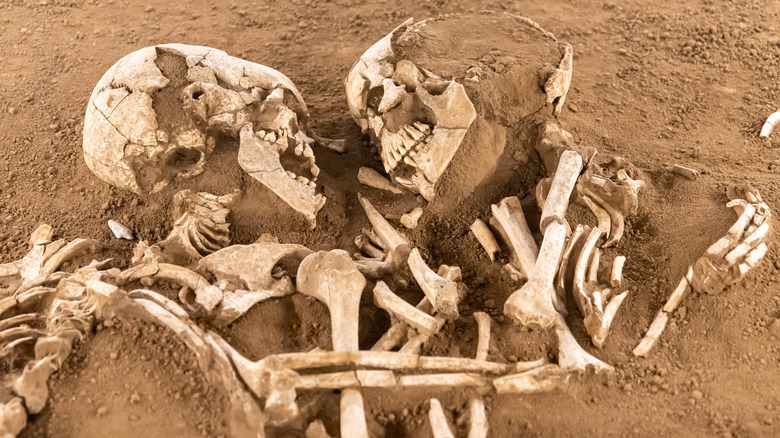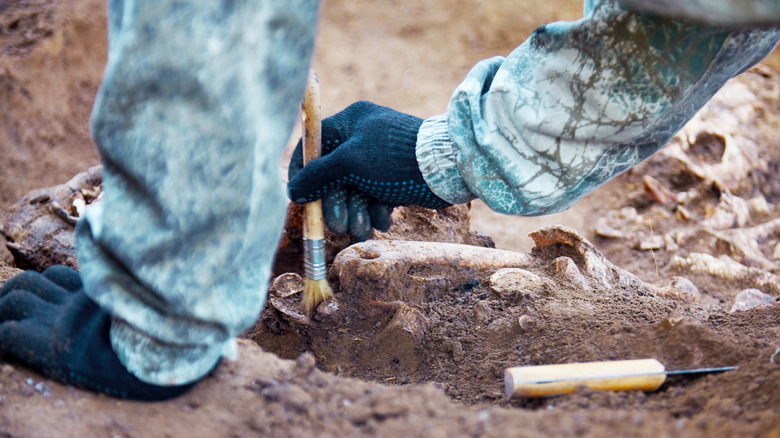The Unsolved Mystery Of The Hasanlu Lovers
In the eighth century B.C., at the site of what is now known as the Solduz Valley in the Western Azerbaijan Province of Iran, a city burned to the ground. Over 900 years later, all that remains are fragile echoes of this incident etched in petrified bone and nearly-fossilized ceramic, with no note of explanation for the humans of the future who find them. There is no written account of what transpired here exactly, and the former inhabitants cannot tell their story. However, there are remnants.
That's what a team of archaeologists from the University of Pennsylvania found when excavating the Teppe Hasanlu archaeological site in 1973, according to Penn Museum's "Expedition." And they discovered a scene so evocative it has inspired waves of theorizing and romanticization from academics and laypeople alike. The iconic photo depicts two skeletons, dubbed SK336 (left) and SK335 (right), that were discovered in a bin-like structure of mudbrick and plaster with their arms intertwined. SK336's hand is gently touching what would have been the cheek of SK335, with its body turned toward his, and the two — lying in what was most likely a bare, airless pit — appear to be embracing, holding each other until they died. Neither skeleton shows signs of apparent disease or injury.
What Happened?
The skeletons were dubbed the "Hasanlu lovers," and they joined the annals of the Lovers of Valdaro (per Jezebel), the Lovers of Cluj-Napoca (via Huffington Post), the Lovers of Modena (per BBC), and the Embracing Skeletons of Alepotrypa (via National Geographic). The site of Hasanlu's destruction is a monument to devastation and violence, but it is exactly amidst, and perhaps because, of this scene that SK335 and SK336 were to be found embracing, even while likely suffocating in the dark in a bare, plastered pit.
SK335 was likely a young male between 19-22 years old. SK335 was slightly older, most likely between the ages of 30 and 35 (via Penn Museum). While the majority of the 256 skeletons found at the Teppe Hasanlu archaeological site were adorned with jewelry and ornaments, the lovers were found bare. There were no other artifacts found in the pit, and neither skeleton showed signs of head trauma or sudden injury. They most likely died of asphyxiation.
Were They in Love?
Like the Lovers of Modena, the skeletons dubbed the Hasanlu lovers likely both belonged to men. Upon initial discovery in the 1970s, SK336 was classified as female. However, a closer look at the pelvis, an examination of the cranium, and the results of additional DNA testing led researchers to amend their findings in 2017: Sk336 was probably male after all (per All That's Interesting). This finding was scandalous, and those following the discovery quickly penned think pieces (like this one in Penn Museum's "Expedition") firmly stating the Hasanlu lovers were probably not lovers, actually, and it was prosaic historical positivism to ever have assumed so. No, they were likely just friends.
Were they? Who knows, and who cares if they "knew" each other in the biblical sense — the scene of the Hasanlu lovers is unmistakably one of intimacy. While language and legend might not survive millennia and love leaves fewer artifacts behind, the history of civilization might be crafted by war, but it is not defined by it. History, like the present, is a story of experiences and relationships — some of which survive trauma, and even, perhaps, three thousand years.


